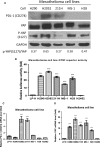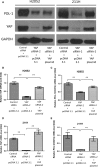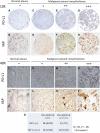Inhibition of yes-associated protein down-regulates PD-L1 (CD274) expression in human malignant pleural mesothelioma
- PMID: 29575535
- PMCID: PMC5980156
- DOI: 10.1111/jcmm.13593
Inhibition of yes-associated protein down-regulates PD-L1 (CD274) expression in human malignant pleural mesothelioma
Abstract
Although tumour PD-L1 (CD274) expression had been used as a predictive biomarker in checkpoint immunotherapy targeting the PD1/PD-L1 axis in various cancers, the regulation of PD-L1 (CD274) expression is unclear. Yes-associated protein (YAP), an important oncogenic protein in Hippo signalling pathway, reportedly promotes cancer development. We investigated whether inhibition of YAP down-regulates PD-L1 (CD274) in human malignant pleural mesothelioma (MPM). Western blotting showed that 2 human MPM cell lines (H2052 and 211H) had increased PD-L1 protein expression compared to H290, MS-1 and H28 cells. In H2052 and 211H cells, PD-L1 mRNA expression was significantly increased compared to other MPM cell lines; YAP knockdown by small interfering RNA decreased PD-L1 protein and mRNA expression. Forced overexpression of the YAP gene increased PD-L1 protein expression in H2452 cells. Chromatin immunoprecipitation (ChIP) assay showed the precipitation of PD-L1 enhancer region encompassing 2 putative YAP-TEAD-binding sites in H2052 cells. We found that, in human MPM tissue microarray samples, YAP and PD-L1 concurrently expressed in immunohistochemistry stain (n = 70, P < .05, chi-square). We conclude that PD-L1 is correlated with YAP expression, and inhibition of YAP down-regulates PD-L1 expression in human MPM. Further study of how YAP regulates PD-L1 in MPM is warranted.
Keywords: PD-L1; checkpoint immunotherapy; hippo signaling; malignant pleural mesothelioma; yes-associated protein.
© 2018 The Authors. Journal of Cellular and Molecular Medicine published by John Wiley & Sons Ltd and Foundation for Cellular and Molecular Medicine.
Figures






Similar articles
-
Inhibition of cyclin-dependent kinase 7 down-regulates yes-associated protein expression in mesothelioma cells.J Cell Mol Med. 2020 Jan;24(1):1087-1098. doi: 10.1111/jcmm.14841. Epub 2019 Nov 21. J Cell Mol Med. 2020. PMID: 31755214 Free PMC article.
-
Targeting YAP in malignant pleural mesothelioma.J Cell Mol Med. 2017 Nov;21(11):2663-2676. doi: 10.1111/jcmm.13182. Epub 2017 May 4. J Cell Mol Med. 2017. PMID: 28470935 Free PMC article.
-
Hippo effector YAP directly regulates the expression of PD-L1 transcripts in EGFR-TKI-resistant lung adenocarcinoma.Biochem Biophys Res Commun. 2017 Sep 16;491(2):493-499. doi: 10.1016/j.bbrc.2017.07.007. Epub 2017 Jul 3. Biochem Biophys Res Commun. 2017. PMID: 28684311
-
The Role of Yes-Associated Protein (YAP) in Regulating Programmed Death-Ligand 1 (PD-L1) in Thoracic Cancer.Biomedicines. 2018 Dec 7;6(4):114. doi: 10.3390/biomedicines6040114. Biomedicines. 2018. PMID: 30544524 Free PMC article. Review.
-
Epidermal Growth Factor Receptor (EGFR) Pathway, Yes-Associated Protein (YAP) and the Regulation of Programmed Death-Ligand 1 (PD-L1) in Non-Small Cell Lung Cancer (NSCLC).Int J Mol Sci. 2019 Aug 5;20(15):3821. doi: 10.3390/ijms20153821. Int J Mol Sci. 2019. PMID: 31387256 Free PMC article. Review.
Cited by
-
Integrating Genetic Alterations and the Hippo Pathway in Head and Neck Squamous Cell Carcinoma for Future Precision Medicine.J Pers Med. 2022 Sep 20;12(10):1544. doi: 10.3390/jpm12101544. J Pers Med. 2022. PMID: 36294681 Free PMC article. Review.
-
Molecular profile of pure squamous cell carcinoma of the bladder identifies major roles for OSMR and YAP signalling.J Pathol Clin Res. 2022 May;8(3):279-293. doi: 10.1002/cjp2.261. Epub 2022 Mar 14. J Pathol Clin Res. 2022. PMID: 35289095 Free PMC article.
-
YAP1 expression is associated with survival and immunosuppression in small cell lung cancer.Cell Death Dis. 2023 Sep 26;14(9):636. doi: 10.1038/s41419-023-06053-y. Cell Death Dis. 2023. PMID: 37752152 Free PMC article.
-
Verteporfin suppresses the proliferation, epithelial-mesenchymal transition and stemness of head and neck squamous carcinoma cells via inhibiting YAP1.J Cancer. 2019 Jul 10;10(18):4196-4207. doi: 10.7150/jca.34145. eCollection 2019. J Cancer. 2019. PMID: 31413738 Free PMC article.
-
Targeting the secreted RGDKGE collagen fragment reduces PD‑L1 by a proteasome‑dependent mechanism and inhibits tumor growth.Oncol Rep. 2023 Feb;49(2):44. doi: 10.3892/or.2023.8481. Epub 2023 Jan 12. Oncol Rep. 2023. PMID: 36633146 Free PMC article.
References
-
- Flores RM, Zakowski M, Venkatraman E, et al. Prognostic factors in the treatment of malignant pleural mesothelioma at a large tertiary referral center. J Thorac Oncol. 2007;2:957‐965. - PubMed
-
- Vogelzang NJ, Rusthoven JJ, Symanowski J, et al. Phase III study of pemetrexed in combination with cisplatin versus cisplatin alone in patients with malignant pleural mesothelioma. J Clin Oncol. 2003;21:2636‐2644. - PubMed
Publication types
MeSH terms
Substances
Grants and funding
LinkOut - more resources
Full Text Sources
Other Literature Sources
Medical
Research Materials

